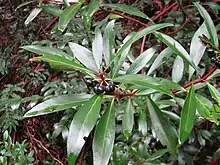Tasmannia
Tasmannia is a genus of woody, evergreen flowering plants of the family Winteraceae. The 40 species of Tasmannia are native to Australia, New Guinea, Sulawesi, Borneo, and the Philippines. The Winteraceae are magnoliids, and are associated with the humid Antarctic flora of the Southern Hemisphere. The members of the family generally have aromatic bark and leaves, and some are used to extract essential oils. The peppery-flavored fruits and leaves (especially dried) of this genus are increasingly used as a condiment in Australia. The peppery flavour can be attributed to polygodial.
| Tasmannia | |
|---|---|
 | |
| Tasmannia lanceolata Mount Donna Buang, Victoria, Australia | |
| Scientific classification | |
| Kingdom: | Plantae |
| Clade: | Tracheophytes |
| Clade: | Angiosperms |
| Clade: | Magnoliids |
| Order: | Canellales |
| Family: | Winteraceae |
| Genus: | Tasmannia R.Br. |
Taxonomy
The first description of the genus was published by Robert Brown.[1][2] The species of Tasmannia were formerly classified in genus Drimys, a related group of Winteraceae native to the Neotropics. Recent studies have led to an increasing consensus among botanists to split the genus into two, with the Neotropical species remaining in genus Drimys, and the Australasian species classified in genus Tasmannia.[3]
List of Tasmannia species
36 species are currently accepted:[4]
- Tasmannia acutifolia – New Guinea
- Tasmannia arfakensis – New Guinea
- Tasmannia beccariana – New Guinea
- Tasmannia brassii – New Guinea
- Tasmannia buxifolia – New Guinea
- Tasmannia coriacea – New Guinea
- Tasmannia cyclopum – New Guinea
- Tasmannia densifolia – New Guinea
- Tasmannia dictyophlebia – New Guinea
- Tasmannia elongata – New Guinea
- Tasmannia fistulosa – New Guinea
- Tasmannia glaucifolia fragrant pepperbush – New South Wales
- Tasmannia grandiflora – New Guinea
- Tasmannia hatamensis – New Guinea
- Tasmannia insipida brush pepperbush – New Guinea and eastern Australia
- Tasmannia lamii – New Guinea
- Tasmannia lanceolata mountain pepperbush (Aus) or Cornish pepperleaf (UK) – New South Wales and Tasmania
- Tasmannia macrantha – New Guinea
- Tasmannia membranea pepper tree – northeastern Queensland
- Tasmannia microphylla – New Guinea
- Tasmannia montis-wilhelmii – New Guinea
- Tasmannia myrtoides – New Guinea
- Tasmannia obovata – New Guinea
- Tasmannia oligandra – New Guinea
- Tasmannia pachyphylla – New Guinea
- Tasmannia parviflora – New Guinea
- Tasmannia piperita – Borneo, Lesser Sunda Islands, Maluku, New Guinea, Philippines, Solomon Islands, Sulawesi
- Tasmannia pittosporoides – New Guinea
- Tasmannia purpurascens broadleaf pepperbush – New South Wales
- Tasmannia reticulata – New Guinea
- Tasmannia rosea – New Guinea
- Tasmannia rubiginosa – New Guinea
- Tasmannia stipitata Dorrigo pepper – New South Wales
- Tasmannia vaccinioides – New Guinea
- Tasmannia verticillata – New Guinea
- Tasmannia vickeriana Baw Baw pepper – New South Wales and Victoria
- Tasmannia xerophila alpine pepperbush – New South Wales and Victoria
Distribution and habitat
In Australia, the genus Tasmannia ranges from Tasmania and eastern Victoria and New South Wales to southeastern Queensland, and in the mountains of northeastern Queensland, where it grows in moist mountain forests and in wet areas in the drier forest and along watercourses to an elevation of 1500 m (5000 ft).
Culinary use
'Tasmanian pepper' or 'mountain pepper' (T. lanceolata, often referred to as Drimys lanceolata or T. aromatica) was the original pepperbush used by colonial Australians, and was introduced into cultivation in Cornwall, UK, to become the 'Cornish pepperleaf' associated with Cornish cuisine. It has large, peppery berries which are also high in antioxidants. Safrole is the biggest limitation with using wild strains of mountain pepper, and safrole-free strains of mountain pepper have been selected for the spice trade.
Tasmannia stipitata, Dorrigo pepper, is also sold as a spice and was the original pepperbush used in specialty native food restaurants in the 1980s. Dorrigo pepper is safrole free and has a strong peppery flavour.
See also
References
Notes
- in a contribution to Augustin-Pyramus de Candolle, Regni Vegetabilis Systema Naturale, Vol. 1, Paris (1818): 445.
- "Tasmannia". Australian Plant Name Index (APNI), IBIS database. Centre for Plant Biodiversity Research, Australian Government.
- Doust, A.N., Drinnan, A.N., Floral development and molecular phylogeny support the generic status of Tasmannia (Winteraceae), American Journal of Botany, Vol. 91, pp321-331., 2004
- Tasmannia R.Br. ex DC. Plants of the World Online, Kew Science. Accessed 2 February 2023.
Bibliography
- Doust, Andrew N. and Drinnan, Andrew N., 2004. Floral development and molecular phylogeny support the generic status of Tasmannia (Winteraceae). American Journal of Botany 91: 321–331.
- Sampson, F.B., Williams, J.B. and Woodland, Poh S., The Morphology and Taxonomic Position of Tasmannia glaucifolia (Winteraceae), 1988. A New Australian Species. Australian Journal of Botany 36 (4): 395–414.
- Smith, Keith and Irene. 1999. Grow your own bushfoods. New Holland Publishers, Sydney, Australia.
- Robins, Juleigh. 1996. Wild Lime: Cooking from the bushfood garden. Allen & Unwin Pty Ltd, Sydney, Australia.
- Bryant, Geoff. 2005. The Random House Encyclopedia of Australian Native Plants. Random House, Sydney, Australia.
- Australian Broadcasting Corporation. Flora's native plants. ABC Books, Sydney, Australia.
- Low, Tim. 1991. Wild food plants of Australia. Angus & Robertson Publishers, Sydney, Australia.